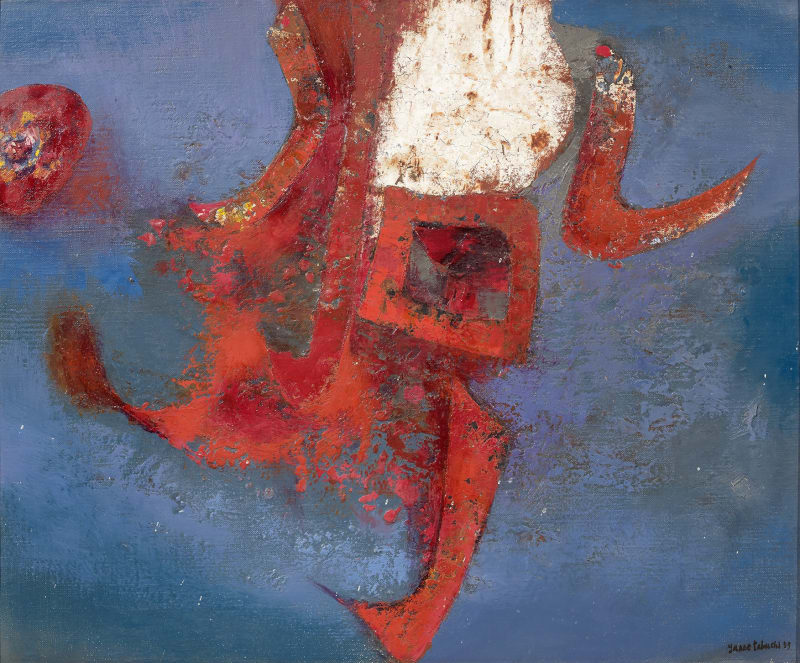Yasse Tabuchi was born in 1921 in Kitakyushu, southern Japan. He was first drafted into the navy and air force during the Second World War, and went on to study Art History at Tokyo Imperial University between 1946 and 1951. At the same time, he took part in exhibitions from 1947, and was awarded the Okada Prize in 1949. In 1950, a selection of works from the Salon de Mai presented in Tokyo aroused his curiosity.
Fascinated by avant-garde painting, he decided to move to Paris in 1951. Initially based in the Cité Universitaire, he later sublet a studio on rue Delambre, where he lived next door to Kumi Sugai. He enrolled at Sorbonne Paris IV University, where he made friends with Alechinsky, Dubuffet, Michaux and Hartung. He became close to the artists of the COBRA movement, including Karel Appel, Corneille and Asger Jorn.
From 1953, he exhibited at the Salon des Réalités Virtuelles, then from 1955 at the Salon de Mai. He frequented the Dôme, where he met all the young artists who had come to Paris. His great curiosity led him to visit Europe. He went to Denmark, where he became interested in Scandinavian archaeology, and held his first solo exhibition in Copenhagen in 1954. A second exhibition was held in 1955 at the Palais des Beaux-Arts in Brussels. He also traveled to the Netherlands and Germany, before his first exhibition organized by Galerie Lucien Durand in Paris in 1956.
Tabuchi's works are marked by organic forms, inspired by nature and sometimes evoking cosmic landscapes; often featuring a palette of bright, luminous colors, dominated by blue, red, yellow and orange; but also a free gestural style reminiscent of Japanese calligraphy and action painting. Abandoning the surrealist tendencies of his early canvases, Tabuchi elaborates a poetic figuration, a mixture of inner images and mystical emblems evoked by pictorial signs. The graphic style of his early work has disappeared, and his compositions are reduced to patches of color. “A vegetal and chromatic explosion in which supple lines and shapes spontaneously submit to a composition that is both dynamic and stable” (Georges Boudaille, Yasse Tabuchi exhibition, ‘Cimaise’ magazine, March-April 1956).
Tabuchi occupies a singular place in the new Ecole de Paris. A watercolorist, engraver, lithographer and ceramist, he is a discreet and inspired personality. In 1959, he moved to the Essonne village of Vauhallan, where he lived and worked for the rest of his life. He was close to Foujita, who lived nearby. Although he produced his work in France from 1951 until his death, he retained a strong influence of his Japanese origins in his work, which explains why we often find recurring traditional motifs and rainbow prisms derived from white patches he called “monads”. He also makes regular use of gold leaf and the diptych format.
He returned to Japan in 1960 for a major exhibition at the Tokyo Gallery. In 1964, he signed a contract with Jean Pollak, director of the prestigious Galerie Ariel in Paris. He published seven books in his native language, focusing on the comparative sensibilities and thoughts of East and West.
The artist has created a number of architectural decorations, including the major hall complex at the Philips Cultural Center in Eindhoven (Netherlands) and the immense ceramic wall at the 20th Century Art Museum in Ikeda, Japan. His work has been exhibited in numerous solo and group shows in France, Japan and Belgium. Several retrospectives have been devoted to his work: in 1982 at the Kitakyushu Municipal Museum, in 1990 at the Tokyo National Museum and in 2014 at the Kamakura Museum of Modern Art in Japan.
In 1985, he was awarded the medal of Officier des Arts et des Lettres. He passed away in 2009 in Vauhallan at the age of 88.
